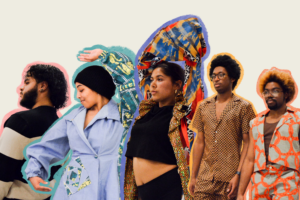“Five, six, seven, eight!”
This call to order invigorates the otherwise quiet and corporate interior of the Healey Family Student Center (HFSC). Heels clack against the hardwood in sync. Lively gritos echo throughout the building. Vibrant ruffled skirts fan out with every spin, imposing themselves on the greige walls of the HFSC dance studio and hypnotizing all who pass by. With an undeniable commitment to its art, Ballet Folklórico Mexicano de Georgetown (BFMG) is more than ready to command your attention at its annual spring showcase in Gaston Hall on April 28.
BFMG is a student-run dance ensemble dedicated to sharing traditional Mexican folk dance. Every year they present a comprehensive cultural showcase, highlighting niche sects of folklórico from all over Mexico. This year’s show, titled “Plaza Hoya: Noche de los Animales,” plays with performance; the majority of their numbers are choreographed in the image of a certain animal.
“You’ll see dancers acting like the animals that the song is named after,” Amy Cazares (CAS ’24), the group’s co-director, said. “We wanted to really tap into the dances and costumes that we haven’t used at all. So, that’s what we’ll be doing!”
Perhaps the dance most indicative of this theme is “El Toro Mambo.” Originating from Sinaloa, Mexico, “El Toro Mambo” depicts a playful spat between bulls and humans. Introduced by the blaring of trumpets, dancers playfully twirl their skirts to entice the “bulls,” creating a kaleidoscope of brilliant yellow, orange, and pink. The skirts’ delicate motions juxtapose the bulls’ aggression; they charge onto the stage stomping and clattering their feet, but the sound of their footwork only compliments the accompanying music. Full of movement, sound, and color, there is never a dull moment in “El Toro Mambo.”
More often than not, Mexican folk dance is known for its difficult-to-execute and often contradictory movements. While the footwork is sharp, with each step striking the ground, the arm motions must be smooth and flowing as the dancers channel the air around them to billow their skirts. The contrast between these two simultaneous moves is entrancing yet onerous. Despite the technical difficulty, BFMG is almost entirely comprised of beginner dancers and a leadership team committed to compassionate teaching.
“Even if you don’t know how to dance, even if you have two left feet, we want you here,” Adriel Perez (CAS ’25), one of BFMG’s choreographers, said. “When I teach, I try to adjust to everyone. I try to focus on everyone’s skill level and make it understandable for everyone. Dancing is only fun when you’re having fun.”
Upon viewing rehearsals, it becomes abundantly clear that BFMG is not just a group of student dancers; it is more reminiscent of a found family, full of people who have found community with like-minded peers. Georgetown’s student body is predominately white and wealthy, making it easy for minority populations to be overshadowed and underrepresented. Brought together by similar backgrounds and cultural affinity, BFMG acts as a guiding light, encouraging students to come out of the shadows and find comfort in one another.
“A big part of our group is that we come from very, very similar backgrounds. Maybe we’re all in GSP [Georgetown Scholars Program] or maybe we’re all first-gen, low-income students. It’s really nice to talk to people who get it. With peace and love, a lot of people at this school do not understand what it’s like to come from a background which we are from,” Cazares said.
More than just a dance group committed to its artistry, BFMG has become a home away from home for its members. BFMG has become an enclave of latinidad, where the Spanish language reigns supreme and students partake in the cultural customs they may have left at home; the group empowers students to come into their own.
“[In BFMG], I can find a space and express art like this that you don’t see a lot. It’s such a unique form of dancing,” Juliana Melara-Recinos (CAS ’27), a new member of BFMG, said. “What I’ll take from [this experience], is that I can find a voice and I can find spaces like this where I feel like I belong.”
This sense of belonging and trust between members breathes life into their work. In their dance representing Hidalgo, Mexico, the dancers are inches away from one another, closely weaving their bodies around their partners. Rather than looking at their feet, the dancers hold intense eye contact, gazing at each other with an undeniable sense of care and gratitude. As the guitar sings in the background, guiding their movements, it becomes nearly impossible to watch the dancers interact without a smile creeping across your face.
Though Hidalgo only features four dancers––Cazares, Perez, Xavi Molina (CAS ’25), and Nini Skevofilax (SFS ’26)––non-participating members in rehearsal could be seen watching intently, eyes glimmering with awe, if not attempting to recreate the moves themselves. At the end of every number, raucous applause swiftly followed.
BFMG oozes with creativity and sheer talent, but only talking about their skill would eclipse the aspect they value most: community building. An unmistakable warmth envelopes every space BFMG chooses to make its own. When reviewing steps together, subsequent success is rewarded with joyful cheers and hugs abound, as dancers insist on helping one another however they can. Through familia nights filled with food, music, and more dancing, BFMG strengthens its performances by building a firm foundation of shared trust and compassion.
Intense competition and elitism often shroud the dance world, lacing the space with negativity. However, as BFMG serves up intricate performances with a side of love, they break away from the status quo. Put most eloquently by Cazares: “Where else on campus could you find this?”
Plaza Hoya: Noche de los Animales will take place April 28 at 8 p.m. in Gaston Hall and will include guest performances from Ritmo y Sabor, GUVSA, GW Folklorico, and Victoria Saeki-Serna. Tickets are free and can be reserved on Eventbrite.





